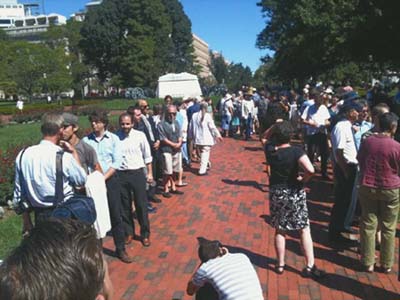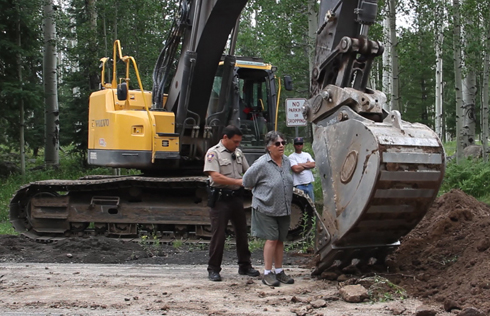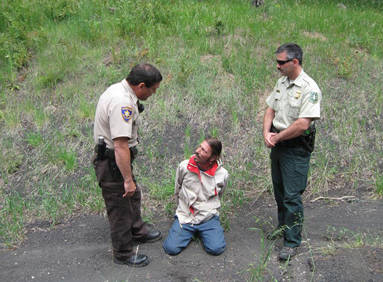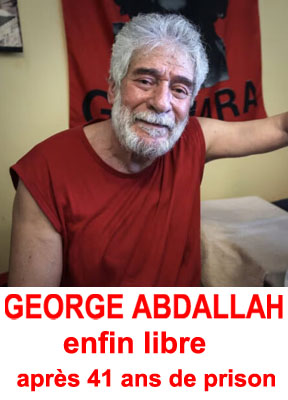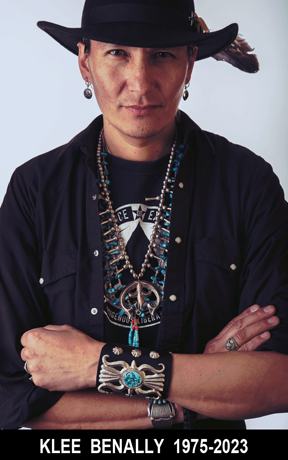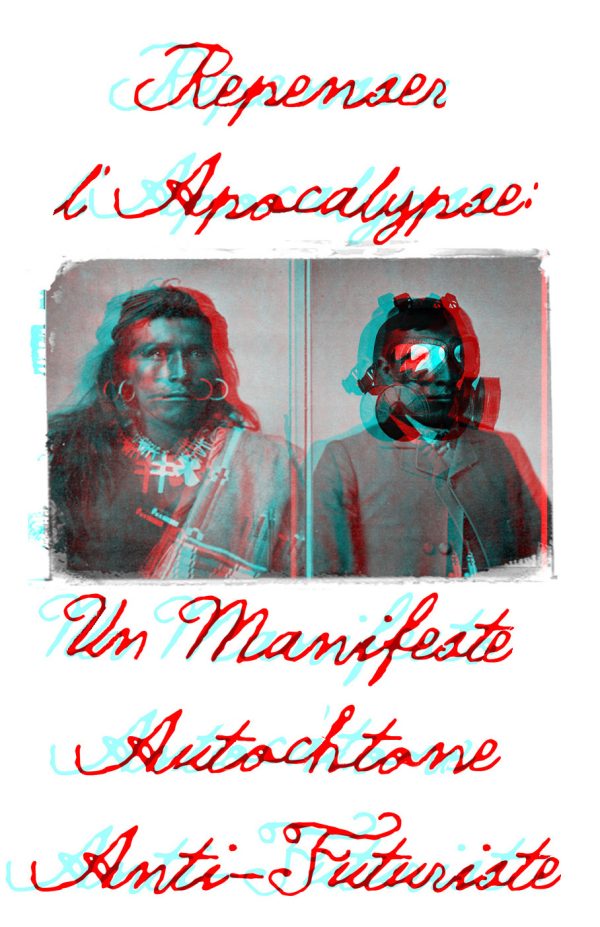Lining up to be arrested today, Tuesday, at the White House. Photo by Tar Sands Action
Mardi 23 août 2011
52 personnes ont été arrêtées hier matin – lundi 22 août – ce qui portait à 162 le nombre d’arrestations. Il n’y a pas que des Amérindiens parmi les manifestants, loin de là. Il y a aussi de nombreux écolos et autres citoyens inquiets pour leur santé et l’environnement, des fermiers du Nebraska, etc…
Des célébrités ont rejoint le mouvement, parmi lesquelles l’actrice Cree Tantoo Cardinal qui a joué entre autres dans ‘Dance avec les loups’. Il faut dire qu’elle est originaire de Fort McMurray, Alberta, qui est au centre de la région des sables bitumineux.
Il semble que le New York Times soit dans l’opposition cette fois-ci, on pouvait lire dans l’éditorial d’hier matin – lundi 22 août – que « Le Département d’Etat devrait reconnaître le risque que présente l’oléoduc pour l’environnement et les dégâts à une encore plus grande échelle causés par l’exploitation des sables bitumineux et bloquer Keystone XL. »
POUR PUBLICATION IMMEDIATE
Original article in English:
www.hopi-nsn.gov/
Par La Tribu Hopi
Traduction Christine Prat
22 août 2011
La Tribu Hopi a engagé une procédure de litige contre la ville de Flagstaff pour avoir imposé le contrat illégal de vente d’eau recyclée à Snowbowl
KYKOTSMOVI, Arizona – Vendredi 19 août 2011, la Tribu Hopi a engagé une poursuite contre la ville de Flagstaff en Arizona, devant la Cour Supérieure du comté de Coconino, concernant la décision prise par la ville en septembre 2010 de ne pas modifier ou annuler le contrat pour la vente d’eaux usées recyclées à la station de ski Arizona Snowbowl pour faire de la neige.
La requête des plaignants déclare que le contrat signé par la ville pour vendre 1,5 millions de gallons d’eaux usées recyclées par jour à Snowbowl est illégal car il enfreint plusieurs lois de l’Arizona sur l’utilisation d’eau recyclée. Le contrat prévoit l’utilisation d’eau recyclée dans une région montagneuse où les écoulements et les inondations ne peuvent être prévenus comme l’exige la loi d’Arizona. De plus les restrictions des contacts des êtres humains avec l’eau recyclée ne peuvent être assurées et les dégâts possibles au milieu alpin unique du site, qui héberge des animaux et des plantes rares, ne peuvent être empêchés. Le contrat est également illégal vis-à-vis de la loi de l’Arizona car il mènera à une dégradation disproportionnée de l’environnement et épuisera davantage les ressources en eau potable déjà très limitées. Ainsi qu’il est déclaré dans la formulation de la plainte, l’utilisation d’eaux recyclées pour faire de la neige affectera l’environnement de manière irraisonnée, constituera une nuisance pour le public et enfreindra le droit du public, y compris la Tribu Hopi, à l’utilisation et la jouissance du site autour de Snowbowl et enfreindra également les droits sur l’eau garantis à la Tribu Hopi.
La vente par la ville d’eaux usées recyclées à Snowbowl couvrira une partie des Pics San Francisco de neige artificielle faite d’eau des égouts. Les Pics San Francisco, et en particulier le site de Snowbowl, sont uniques sur le plan écologique et abritent des types d’habitat et d’espèces rares. Le contrat illégal de la ville autorise à répandre et diffuser des eaux usées sur des sites sauvages utilisés spécifiquement par les Hopis et d’autres tribus, mettant des obstacles et enfreignant l’utilisation et la jouissance de ces sites par la Tribu Hopi et d’autres.
Les eaux usées recyclées sont des eaux qui ont été utilisées et recyclées dans le système de distribution d’eau de la ville. La fonte de neige artificielle faite d’eau recyclée sera dommageable pour l’environnement car elle contiendra des composants chimiques comme des perturbateurs endocriniens qui affectent le niveau normal et le fonctionnement des hormones chez les humains et les animaux. Les effets négatifs des perturbateurs endocriniens sont entre autres des développements sexuels aberrants, et des problèmes de comportement et de reproduction. Des espèces fondamentales dans l’écosystème des San Francisco Peaks comme les grenouilles sont particulièrement susceptibles d’en être affectées.
La Tribu Hopi montrera que le contrat illégal pour la vente d’eau recyclée à Snowbowl résultera au final en une perte économique considérable pour la communauté des San Francisco Peaks. Le petit accroissement de ses profits espéré par Snowbowl et les bénéfices minimes pour la région seront plus que compensés par des coûts bien plus élevés, y compris les dommages causés à l’environnement, pour la communauté des San Francisco Peaks, dont la Tribu Hopi. Les effets des eaux recyclées ne peuvent être limités au terrain de la station de ski, donc les utilisateurs des Pics dans les sites vitaux et accessibles autour de Snowbowl seront affectés si le contrat illégal est maintenu. La Tribu Hopi cherche a obtenir une décision de justice interdisant la réalisation de ce contrat de vente d’eaux usées recyclées à Snowbowl, ce contrat ayant un but illégal et étant contraire à la politique publique.
Le Président de la Tribu Hopi Leroy Shingoitewa a souligné l’importance de l’affaire pour la Tribu Hopi : « la santé et la sécurité du peuple Hopi est inséparable de la santé et la sécurité de l’environnement – la protection de l’environnement sur les San Francisco Peaks est fondamentale pour l’existence de la Tribu. L’utilisation d’eau d’égouts recyclée sur les San Francisco Peaks prévue par la ville de Flagstaff et Snowbowl aura un impacte négatif direct sur les usages fréquents et vitaux des Pics par la Tribu Hopi. »
Les défenseurs des San Francisco Peaks appellent à l’organisation de manifestations devant les sièges régionaux du Service des Fôrets US et le siège principal à Washington D.C.
Une manifestation est déjà organisée pour jeudi, 25 août, à Albuquerque, Nouveau Mexique. D’autres sont en train de s’organiser.
APPEL A LA MANIFESTATION DU 25 AOUT A ALBUQUERQUE, N.M.
Par TrueSnow.org
PROTEGEZ LES SITES SACRES ! DEFENDEZ LES DROITS DE L’HOMME !
MANIFESTATION POUR PROTEGER LES PEAKS
Quand : Jeudi, 25 août – Toute la journée de 9h à 17h (heure locale)
Où : Southwestern Regional Forester Office (Office Forestier Régional du Sud-Ouest)
333 Broadway SE, Albuquerque, NM.
Pourquoi : Depuis le 25 mai 2011,les propriétaires d’Arizona Snowbowl, soutenus par le Service des Fôrets des Etats-Unis et le Conseil Municipal de Flagstaff, ont posé plus de cinq miles sur 14,8 d’un pipeline pour transporter des eaux usées et ont abattu plus de 40 acres d’une forêt alpine rare sur les Pics Sacrés San Francisco au nord de l’Arizona. Les Pics sont sacrés pour plus de 13 Nations Autochtones. Ils sont un lieu de culte, un lieu où des divinités résident, un lieu où l’on fait des offrandes, où des plantes médicinales sont cueillies, l’endroit où l’Emergence a eu lieu, et un site où bien d’autres pratiques religieuses se tiennent.
Le Ministère de l’Agriculture des Etats-Unis (USDA), l’administration chargée du Service des Forêts, est en train de tenir des consultations sur la protection des sites sacrés, en partie à cause de la controverse suscitée par les Peaks.
Il faut demander au représentant régional du Service des Forêts et au Ministère de l’Agriculture d’arrêter immédiatement les travaux d’expansion de Snowbowl sur les San Francisco Peaks !
Le Service des Forêts et le Ministère de l’Agriculture (USDA) peuvent bloquer cette profanation et cet écocide !
Pour plus d’informations (en Anglais) : TrueSnow.org
PASSEZ A L’ACTION :
1. Prenez contact avec le Ministère de l’Agriculture (US Department of Agriculture)
Demandez au Ministère d’arrêter immédiatement les travaux d’expansion sur les San Francisco Peaks !
Etant donné que le Ministère dirige le Service des Forêts, demandez qu’il révoque le Permis d’Utilisation Spéciale d’Arizona Snowbowl, dans l’intérêt supérieur du public.
Adresse du Ministre (Secretary) :
Tom Vilsack
U.S. Department of Agriculture
1400 Independence Avenue, S.W.
Washington, DC 20250
Téléphone: 202-720-3631
2. Les citoyens Américains peuvent envoyer des commentaires sur le projet de Rapport sur les Sites Sacrés, avant le 4 0ctobre 2011.
Le rapport se trouve sur : http://www.fs.fed.us/spf/tribalrelations/sacredsites et les commentaires peuvent être envoyés par email à sacredsitescomment@fs.fed.us , par fax au 202-205-1771, par lettre à :
U.S. Forest Service
Office of Tribal Relations
1400 Independence Avenue, SW
Mailstop Code: 1160
Washington, DC 20250-1160
3. Si vous êtes sur place, convergez sur la montagne!
Rejoignez un camp de base ou établissez le votre.
Ou faites des dons de matériel (ou financiers)
Voir www.truesnow.org
4. Faites des dons pour aider les personnes arrêtées à payer les frais (caution, avocat, amendes…)
Dons en ligne : www.TrueSnow.org ou www.IndigenousAction.org
Contacts : protectpeaks@gmail.com
5. Prenez contact avec les conseillers municipaux de Flagstaff pour leur demander de respecter l’environnement, la culture Autochtone et de protéger la santé publique, en trouvant un moyen de rompre le contrat par lequel ils vendent des eaux usées à Snowbowl !
Email : council@flagstaffaz.gov
Téléphone : 928-779-7600
6. Ecrivez des lettres aux journaux sur le problème, diffusez le message sur les réseaux sociaux.
Les actions de désobéissance civile organisées à Washington pour protester contre l’oléoduc qui doit amener le pétrole extrait des sables bitumineux d’Alberta jusqu’au Golf du Mexique à travers les Etats-Unis, ont commencé samedi. La police a procédé à de nombreuses arrestations dans le but avoué de décourager les autres participants.
22 août 2011
Plus de 2000 personnes – des 50 états des Etats-Unis et du Canada – se sont inscrits sur le site www.tarsandsaction.org pour participer à des actions commencées samedi 20 août et devant durer jusqu’au 3 septembre.
Chaque jour un groupe de 50 à 100 personnes prend par à un « sit-in » et est relayé par un autre groupe le jour suivant.
70 personnes ont été arrêtées samedi et au moins 50 dimanche. La police a admis procéder à ces arrestations dans le but de décourager ceux qui doivent les relayer pendant les deux semaines qui suivent. La police se soucierait particulièrement d’éviter les « sit-in » pendant les manifestations officielles qui doivent débuter le 28 août et se poursuivre pendant une semaine à l’occasion de l’inauguration d’un mémorial dédié à Martin Luther King Jr. Ils ont apparemment oublié que Martin Luther King était justement devenu célèbre en prônant la résistance non-violente créative.
Au préalable, la police avait pourtant assuré verbalement aux organisateurs que les manifestants ne risqueraient qu’une amende de 100 dollars et seraient relâchés immédiatement. En fait, les personnes arrêtées samedi sont restées en prison et devraient passer au tribunal ce lundi. Bien que surpris, les organisateurs ont assuré qu’une nuit en prison ne pourrait en aucun cas décourager les futurs participants. Ils considèrent l’affaire de l’oléoduc comme le principal test pré-électoral pour Obama sur le plan de l’environnement.
Sur l’opposition des Nations Autochtones au projet et leurs griefs et arguments, voir article précédent.
En Anglais :
Articles sur les manifestations de ce week-end par Tar Sands Action sur Censored News
Lettre de scientifiques Américains au Président Obama
Au rassemblement pour la Protection de notre Mère la Terre au Dakota du Nord, des activistes des Premières Nations ont annoncé une action de désobéissance civile pour empêcher la construction aux Etats-Unis d’un oléoduc pour les sables bitumineux très polluants.
Par Brenda Norrell
Censored News
Traduction Christine Prat
Lundi 1er août 2011
NEW TOWN, Dakota du Nord – La résistance aux Sables bitumineux très polluants a annoncé des projets de désobéissance civile à Washington pour faire comprendre au gouvernement Obama qu’il faut mettre un terme à un projet d’utilisation du pétrole le plus sale de la planète, qui menace les ressources naturelles et les humains en Amérique du Nord, y compris les territoires Indiens.
S’adressant au Rassemblement Pour Protéger notre Mère la Terre, Clayton Thomas Muller dit que des actions de désobéissance civile sont projetées à Washington pour mettre le gouvernement Obama devant ses responsabilités, maintenant qu’il a entre les mains une décision cruciale concernant l’oléoduc devant transporter les sables bitumineux, projet de TransCanada Corp. Keystone XL.
Muller dit que si cet oléoduc, qui doit aller du Canada au Golf du Mexique, était autorisé, il traverserait des terres sacrées et mettrait en danger les ressources des territoires Indiens, entre autres les nappes aquifères des Lakota.
« C’est un projet absolument délirant, surtout à une époque de changement climatique » dit Muller, ajoutant que les industries de la côte du Golf du Mexique sont déjà en train de se préparer pour ce pétrole sale.
Muller s’est adressé à des représentants de Peuples Autochtones venus pour certains du Guatemala, du Mexique et du Canada, au 16ème Rassemblement Annuel pour la Protection de notre Mère la Terre, organisé par le Réseau Indigène pour l’Environnement du 28 au 31 juillet 2011, à New Town, au Dakota du Nord, au cours duquel ont eu lieu deux réunions de travail sur les moyens d’arrêter les destruction causées par les Sables Bitumineux d’Alberta.
Des Navajos qui combattent les centrales au charbon et le drainage de leurs nappes aquifères par la compagnie charbonnière Peabody Coal étaient présents, et des Wixarika (Huicholes) sont venus chercher des alliés pour mettre un terme à l’exploitation minière de la First Majestic Silver Corp. de Vancouver (British Columbia), qui détruit leurs montagnes sacrées.
Le Rassemblement s’est tenu sur les terres des Mandan, Hidatsa et Arikara, où les Amérindiens combattent un projet approuvé par le Bureau des Affaires Indiennes pour le forage de 3000 puits de pétrole et de gaz. Déjà, l’air, l’eau et la terre sont dévastés par les nombreux puits de pétrole et de gaz, et les forages, le trafic des poids lourds et l’explosion du nombre de travailleurs du pétrole et du gaz ravagent l’environnement, l’économie et la vie quotidienne des gens.
Avec pour but la fermeture des industries du fuel fossile et l’arrêt de l’exploitation des sables bitumineux très polluants en Alberta ainsi que du projet d’oléoduc aux Etats-Unis, Muller a parlé de la récente victoire pour le Caribou.
Au Canada, le juge de la Cour Fédérale Peter Crampton a donné au Ministre de l’Environnement Peter Kent jusqu’au 1er septembre pour publier son plan national de sauvetage du caribou. Selon l’Edmonton Journal, le juge Crampton a déclaré que le gouvernement devait revenir sur son refus de publier un décret d’urgence pour la protection du caribou menacé dans la région des sables bitumineux de l’Alberta.
Plus tôt, le ministre avait repoussé les exigences des Premières Nations et conclu que les sables bitumineux ne constituent pas une menace imminente pour le sauvetage national du caribou des régions boréales.
D’après le Globe and Mail, aux Etats-Unis le membre du Congrès Alcee Hastings a prévenu que « le risque de fuite de ces oléoducs pour les sables bitumineux est très réel. »
« Le pétrole ronge les oléoducs, les endommageant et conduisant à des fuites fréquentes » a-t-il déclaré au cours du débat sur l’oléoduc proposé par TransCanada Corp. Keystone XL, qui amènera le pétrole brut des sables jusqu’à la côte du Golfe du Mexique s’il est approuvé. Cela fait écho au rapport du Conseil de Défense des Ressources Naturelles, un groupe écologiste puissant aux Etats-Unis, qui a qualifié le pétrole brute des sables bitumineux de substance « hautement corrosive, acide et potentiellement instable » qui « pourrait mettre en danger la santé publique de l’Amérique. »
Le Chef Allan Adam, de la Première Nation Athabasca Chippewa de Fort McMurray, avait dit précédemment que les décisions du Département de Développement de Ressources Durables de l’Alberta, présidé par le Ministre Mel Knight, menacent les Droits de chasse et cueillette traditionnelles garanties par Traité.
La Première Nation Athabasca Chippewa a déclaré que « le gouvernement de la province évitait systématiquement de subvenir aux besoins de base lorsqu’il s’agit d’air, de terres et d’eau dans la région et s’abstenait d’impliquer de manière significative les Premières Nations dans les décisions concernant la gestion des terres conformément aux Droits indigènes garantis par Traité. »
« Tant que l’Alberta ne fera pas d’efforts sérieux pour protéger la terre, réglementer l’industrie et garantir que les Premières Nations sont à la table des négociations en tant que partenaires à part entière pour développer des solutions aux graves défis environnementaux créés par le gouvernement et l’industrie, ils peuvent s’attendre à ce que nous nous opposions à tout développement ultérieur dans la région. »
Au Canada, Leslie Cardinal, appartenant à une Première Nation, a déclaré « Le gouvernement du Canada a accepté la Déclaration des Nations Unies sur les Droits des Peuples Autochtones, suivant un mode conforme à la Constitution et aux lois du Canada. La Déclaration des Nations Unies dit clairement que les Peuples Autochtones ont le droit de maintenir et renforcer leur relation spirituelle distinctive sur les territoires, eaux et autres ressources qui leur appartiennent traditionnellement, ou qu’ils occupent ou utilisent ou de toute autre manière, et de conserver leurs responsabilités vis-à-vis des générations futures.
La Nation Cree de Beaver Lake a lancé une procédure civile de masse pour prouver que l’exploitation débridée du pétrole et du gaz dans leur territoire traditionnel rend leurs droits acquis par traités dénués de sens.
Le document présenté donne une liste de plus de 15000 projets approuvés ou proposés sur leurs terres traditionnelles près du Lac La Biche. D’après l’Edmonton Journal, le clan a dit que « les travaux d’exploitation avaient forcé ses membres à quitter leurs secteurs traditionnels, dégradé l’environnement et fait décliner le nombre d’animaux sauvages, rendant impossible l’exercice effectif de leurs droits de chasse et de pêche garantis par le Traité 6.
Le pétrole brut tiré des sables bitumineux du Canada est lourd et épais, c’est une substance noire semblable à du goudron, qui demande de grandes quantités d’énergie et de travail pour être transformée en produits finis comme l’essence et le diesel. Même certains industriels de l’énergie d’Alberta le décrivent comme un ‘sale truc’, d’après le Globe and Mail.
Les projets d’exploitation des sables pétrolifères menacent les sols, car l’extraction initiale du bitume laisse une grande quantité de dépôts de produits chimiques toxiques. L’exploitation des sables pétrolifères menace l’eau au cours du processus de séparation et à cause du drainage des rivières. De plus, l’air est pollué par l’émission de gaz carbonique et autres. Et la combustion des produits pétroliers, par la suite, cause également l’émission de gaz carbonique dans l’atmosphère. D’après Wikipedia, il y a des métaux lourds dans les sables bitumineux.
You will find below an appeal by True Snow – the site for the Defenders of the Peaks – calling people from Flagstaff to attend a Silent Vigil on August 23.
Those of us who are not citizens of Flagstaff and live very far away could support them by sending emails to the City Council on that day. You can let them know what you feel, just remind them that “Water is Life”, or – what I plan to do – just send a photo of yourself or of any anonymous person with the mouth covered.
Christine Prat
Traduction en Français plus bas
Silent Vigil August 23 – 4PM – City Hall
Water is Life, Don’t sell ours to Snowbowl!
Wear tape or a cloth or something covering your mouth to show how the council has forced silence on this issue!
On Tuesday August 23 we will hold Silent Vigil in front of City Hall and subsequently in city council meeting. It is time to stop for a moment and pay our respects to the plants, trees, animals, and insects who died or lost their homes in the clear-cuts that are taking place up on the mountain at the hands of Arizona Snowbowl.
 It would only take four city council members with courage and vision to end this entire treated sewage effluent fiasco forever. With their simple vote to end the contract it could put an end to anger and racism and outright desecration and begin the healing process. It would also keep 180,000,000 gallons of water a year filtering through 1200 feet of volcanic rock back into our own aquifer, instead of dumping it directly above a perched aquifer on the peaks and uphill from the Hart Prairie aquifer. Flagstaff water for Flagstaff, don’t sell it to Snowbowl.
It would only take four city council members with courage and vision to end this entire treated sewage effluent fiasco forever. With their simple vote to end the contract it could put an end to anger and racism and outright desecration and begin the healing process. It would also keep 180,000,000 gallons of water a year filtering through 1200 feet of volcanic rock back into our own aquifer, instead of dumping it directly above a perched aquifer on the peaks and uphill from the Hart Prairie aquifer. Flagstaff water for Flagstaff, don’t sell it to Snowbowl.
Please join us in the City Council meeting and let them know what their silence feels like. The council chambers can likely hold about 200 people, so come on down and help us fill the room. Let them know that water is life, don’t sell ours to Snowbowl.
———————————————–
Vous trouverez ci-dessous un appel de True Snow – le site des Défenseurs des Pics – appelant les gens de Flagstaff à se joindre à une manifestation silencieuse le 23 août.
Tous ceux d’entre nous qui ne sont pas citoyens de Flagstaff et vivent très loin peuvent les soutenir en envoyant des mails au Conseil Municipal ce jour-là. Vous pouvez leur dire ce que vous pensez si vous êtes inspirés, juste leur rappeler que « l’Eau c’est la Vie » – ce qui est le thème de True Snow – ou bien – ce que je compte faire pour ma part – leur envoyer seulement une photo de vous-même ou un dessin représentant un individu quelconque, avec un bâillon sur la bouche.
MANIFESTATION SILENCIEUSE LE 23 AOUT À 16H – DEVANT L’HOTEL DE VILLE DE FLAGSTAFF
L’Eau est la Vie, ne vendez pas la nôtre à Snowbowl!
Bâillonnez-vous pour montrer comment le Conseil Municipal a imposé le silence sur ce problème !
Mardi 23 août nous organiserons une Manifestation Silencieuse devant l’Hôtel de Ville, puis à la réunion du Conseil Municipal. Il est temps de nous arrêter un moment pour rendre hommage aux plantes, arbres, animaux et insectes qui sont morts ou ont perdu leur habitat lors de l’abattage de la forêt commis en ce moment par Arizona Snowbowl.
Il suffirait de quatre conseillers municipaux courageux et clairvoyants pour mettre un terme définitif au désastre de l’eau d’égout recyclée. Il leur suffirait de voter pour mettre fin au contrat, à la colère et au racisme et à la profanation et mettre en route le processus de réparation. Cela permettrait aussi à 180 millions de gallons d’eau par an de continuer à être filtrés à travers la roche volcanique jusqu’à notre nappe aquifère au lieu d’être balancés directement au-dessus des nappes d’altitude sur les Pics et de la nappe de Hart Prairie. L’eau de Flagstaff est pour Flagstaff, ne la vendez pas à Snowbowl.
Rejoignez nous à la réunion du Conseil Municipal et faites-leur comprendre l’effet que fait leur silence. Les salles du Conseil peuvent contenir environs 200 personnes, alors venez et aidez-nous à remplir l’espace. Faites-leur savoir que l’eau est la vie, et qu’ils ne doivent pas la vendre à Snowbowl.
Original article in English: Klee Benally: Direct Action to Protect Holy Peaks Continues
L’ACTION DIRECTE POUR PROTÉGER LES PICS SACRÉS CONTINUE
Par Klee Benally
www.IndigenousAction.org
Photos Ethan Sing
Publié sur Censored News
14 août 2011
Traduction Christine Prat
Samedi 13 août 2011, après un rassemblement dédié à la prière, mes amis Mary Sojourner, Rudy Preston et moi-même avons été arrêtés par des agents des “forces de l’ordre” pour nous être élevés contre la profanation et l’écocide causés par la station de ski Arizona Snowbowl.
Depuis le 16 juin, 26 arrestations ont eu lieu pendant des manifestations contre la reprise de la profanation et de l’écocide des Pics Sacrés par Snowbowl.
Samedi, alors que le conducteur de l’excavatrice employé par Snowbowl déchirait la terre sacrée, les plantes et les souches pour prolonger vers le haut de la montagne la tranchée destinée au pipeline, 40 personnes se sont rassembler pour prier dans une pâture juste en face du chantier. Par moments, les bulldozers et l’excavatrice n’étaient qu’à 600m de l’assemblée, et le bruit des machines rendait presqu’impossible pour les Anciens de s’exprimer. Le bruit interrompait les déclarations et les prières des personnes présentes.
Bien que je ne puisse pas dire avec certitude comment çà a commencé, après la prière 30 personnes ont commencé à pousser des roches et rejeter de la terre dans la tranchée du pipeline. Tandis que e regardais a distance, chaque rocher remis à sa place dans la tranchée – pour refermer la cicatrice de la profanation – m’apparaissait comme plus puissant que n’importe quelle pétition que j’aie jamais lue.
Deux agents du Service des Forêts, qui apparemment avaient surveillé le rassemblement de prières, ont jailli des bois alors que l’action spontanée se déroulait.
A ce moment, je me suis approché de l’opérateur de l’excavatrice et dit « Arrêtez. Vous avez interrompu et dérangé nos prières. Vous devez arrêter. » Puis je me suis enchaîné et menotté afin de bloquer l’excavatrice.
J’ai été rejoint par plus de 30 personnes qui commencèrent à scander et chanter. Nous avons chanté d’une manière qui constituait une continuation de nos prières. Je suis resté enchaîné à la machine pendant environs deux heures.
Le Service des Forêts et les sheriffs du comté de Coconino m’ont détaché après que Louise Benally – de Big Mountain – ait exprimé sont accord en ce qui me concerne. J’ai été inculpé par le sheriff d’ « Intrusion » et de « trouble 1a l’ordre publique ».
Comment pourrais-je être par « intrusion » sur un site qui est si sacré pour moi ? C’est mon église. Ce sont le Service des Forêts et Snowbowl qui violent les droits de l’homme et la liberté religieuse en profanant cette Montagne Sacrée. Bien qu’un appel soit encore en suspens dans le système judiciaire, Snowbowl essaie de saper la procédure. De plus, Snowbowl et le Service des Forêts violent l’accord de 2004 (MOA, Memorandum of Agreement) signé avec les Nations Autochtones. Cet accord stipule que les Autochtones doivent être consultés avant toute construction, ce qui n’a pas été fait de manière significative, si seulement çà a été fait. Sans parler du fait que le Service des Forêts et Snowbowl violent la Déclaration d’Impacte Environnemental, vu qu’ils n’ont suivi aucune des mesures d’atténuation de l’impact sur l’environnement prévues. Leurs actions vont bien au-delà du « trouble à l’ordre publique. »
Après mon arrestation et ma libération, Mary Sojourner, écrivain et activiste locale, a affronté les agents du Service des Forêts et les sheriffs du comté de Coconino. Elle s’est avancée jusqu’à l’excavatrice pour bloquer la construction du pipeline et a été immédiatement menottée et fourrée dans un car de police.
Mary a déclaré « Je me suis lancée dans l’action, non seulement pour la Montagne, mais pour mon ami Klee Benally, que j’ai vu enchaîné à une monstrueuxe excavatrice, cette machine creusant pour le pipeline, qui a déchiré la montagne et l’air tranquille du matin, alors que trente d’entre nous priaient pour la Montagne ; et aussi pour que les femmes et les hommes âgés voient qu’il n’est pas nécessaire d’être jeune pour se lever pour défendre un lieu et une communauté qu’on aime. »
Rudy Preston, l’avocat local des Pics, a également été arrêté et inculpé de deux chefs de « trouble à l’ordre publique » et d’un pour « intrusion ».
Rudy a fait cette déclaration : « J’ai l’impression que le monde a changé pour toujours hier. Nos actions pour Nuvatukya Ovi (Pics San Francisco en Hopi) m’ont conduit à voir les véritables horreurs perpétrées chaque jour contre les Cultures Indigènes de notre communauté. Même sans eau d’égout sur la montagne, la profanation est la perpétuation du génocide systématique des peuples locaux depuis des siècles, et c’est aussi fort maintenant qu’à l’époque ou des peuples ont été forcés de participer à la Plus Longue Marche. Je ne fermerai plus jamais les yeux sur cette injustice. Et mon corps ne le perpétuera pas. »
Tout ce qui est arrivé au cours du dernier mois a été rendu possible par des individus pensant de cette manière et entreprenant des actions de toutes sortes. J’espère que d’autres sortiront aussi de leur petit confort pour créer des actions qui reflèteront leur participation. Tout le monde ne peut pas défiler dans les rues, tout le monde ne peut pas s’enchaîner, tout le monde n’a pas forcément de voiture. Mais nous aimons tous la montagne et vour n’avez pas besoin d’attendre un ‘organisateur connu’ pour vous dire ce que vous devez faire maintenant. »
Tandis que moi, Klee, j’étais enchaîné à l’excavatrice, je disais « Ceci n’est pas un jeu. Ce n’est pas un spectacle. Ce n’est pas fait pour les média. C’est pour empêcher cette profanation de se produire. »
La construction n’a été stoppée que pendant 2 heures, néanmoins elle a été stoppée. C’est du pouvoir. C’est un pouvoir que nous partageons tous. Si une, trois, six ou neuf personnes peuvent se mettre en travers du chemin des machines et dire « assez », imaginez ce qui pourrait advenir si chaqu’un d’entre nous tous se sentait concerné ?
Ce qui est en jeu, c’est nos prières, nos modes de vie, notre survie culturelle. C’est pourquoi il faut que cela cesse. C’est pourquoi nous disons ‘Pas de profanation pour des activités de récréation, protégez les Pics ! »
Pour plus d’information en Anglais et des dons (pour les frais de caution et de justice) : www.indigenousaction.org ou www.truesnow.org
Vidéo de Klee enchaîné, filmé par M.T. Garcia, sous-titres Ch. Prat
KLEE BENALLY S’ENCHAINE A UNE EXCAVATRICE
Par Brenda Norrell, Censored News
Traduction Christine Prat
Original article in English : Censored News photos-klee-benally-chained
Dimanche 14 août 2011
FLAGSTAFF, Arizona – Le Navajo Klee Benally s’est enchaîné à une excavatrice sur la Route de Snowbowl samedi 13 août, après qu’une machine ait interrompu une assemblée de prières sur les Pics San Francisco. Rudy Preston, agent de liaison avec la police de Protect the Peaks, et Mary Sojourner, écrivain, ont été arrêtés. Ils ont tous deux été libéré sous caution de la prison du comté de Coconino, d’après un message envoyé à Censored News à 1h30 du matin, dans la nuit de samedi à dimanche.
Enchaîné à une excavatrice, Klee déclara « C’est ici que nous traçons une ligne rouge, c’est ici que nons disons çà suffit ! »
« Vous êtes des criminels. Vous autorisez la profanation de ce qui nous est sacré. Vous menacez notre survie culturelle. »
« Quelle part de la notion de sacré ne comprenez-vous pas ? » poursuivit Benally. Ses mots furent répétés par des supporters rassemblés sur le site lorsque la police arriva et qu’un agent du Service des Forêts surgit des bois d’où il les avait filmés.
Benally, toujours enchaîné à l’excavatrice, ajouta « Ceci n’est pas un jeu. Ce n’est pas du spectacle. Ce n’est pas pour les média. C’est pour empêcher cette profanation de continuer. »
Ces mots furent répétés en écho par les autres Amérindiens rassemblés pour bloquer la destruction.
L’écrivain de Flagstaff Mary Sojourner et l’agent de liaison avec la police de Protect the Peaks Rudy Preston furent arrêtés sur place. Preston a été inculpé de deux chefs de trouble à l’ordre publique et d’intrusion illicite. Sojourner a été inculpée tard dans la soirée de dimanche. Klee Benally a été cité à comparaître pour trouble à l’ordre publique puis relâché.
Klee Benally a une réputation internationale comme chanteur du groupe de frères et sœur Navajo Blackfire et comme organisateur d’efforts de défense des San Francisco Peaks contre la destruction.
Mary Sojourner est auteur de deux romans, Sisters of the Dream et Going Through Ghosts ; d’un recueil de nouvelles, Delicate ; d’un recueil d’essais, Bonelight : ruin and grace in the New Southwest ; de mémoirs, Solace : rituals of loss and desire et She Bets Her Life.
Avant l’action de ce dimanche, 17 personnes avaient été arrêtées au cours des huit derniers jours, alors que des Navajos, des Hualapais, des Hopis, des O’odham et d’autres Amérindiens protestaient contre la destruction des montagnes sacrées.
Il est demandé aux touristes de boycotter la station Arizona Snowbowl, propriété d’Eric Borowsky de Scottdale (Arizona).
Pendant la semaine d’action, Protect the Peaks a manifesté devant le siège du Service des Forêts, l’Hôtel de Ville de Flagstaff, et le siège de High Desert Investment Company. High Desert Investment Company, responsable de l’abattage massif d’arbres sur les Pics San Francisco, est la propriété de G. Allen Ribelin, qui possède aussi High Investment Logging à Flagstaff.
La station Arizona Snowbowl a l’intention de fabriquer de la neige pour les touristes à partir d’eaux usées recyclées. Treize Nations Amérindiennes considèrent les montagnes comme sacrées. Les « medicine men » y cueillent des plantes médicinales et y organisent des cérémonies.
L’abattage d’arbres plusieurs fois centenaires a déjà commencé, pour faire passer le pipeline (qui doit amener les eaux usées) et autres projets de l’industrie du tourisme.
Les jeunes Amérindiens sont prêts à se faire arrêter pour mettre un terme à la destruction.
Plus d’infos en Anglais :
www.indigenousaction.org
www.truesnow.org
Plus de photos sur Censored News
BLACKFIRE dans la lutte : alors que le chanteur et guitariste Klee s’enchaînait sur le site des travaux, Jeneda et Clayson transmettaient le message au festival où le groupe devait se produire. Voir la vidéo sur youtube :
http://www.youtube.com/watch?v=yOnsbc97kk8
Lettres et courriels de soutien ou de protestation
Voir Page SAVE THE PEAKS / SAUVEZ LES PICS
Original article in English :
POUR PUBLICATION IMMEDIATE
CONTACTS:
protectpeaks@gmail.com
www.truesnow.org
Un barrage interrompt la destruction et la profanation de la Montagne Sacrée par la station de ski
Traduction Christine Prat
Flagstaff, AZ – 8 août 2011. Neuf personnes ont entrepris une action directe, lundi matin à 5h (heure locale), en bloquant la destruction in cours et la profanation des Pics Sacrés San Francisco. Neuf individus ont affronté directement les actions d’écocide d’Arizona Snowbowl, en arrêtant pendant huit heures les abattages d’arbres et le creusement de tranchée quotidiens. Les suppléants du sheriff arrivés sur place ont arrêté l’agent de liaison avec la police du groupe, qui était là pour assurer la sécurité des manifestants. Plus de 50 agents des autorités ont utilisé des scies industrielles et un marteau-piqueur pour briser de force le barrage.
« L’action d’aujourd’hui fait partie d’une série de manifestations destinées à empêcher la firme Snowbowl, le Service des Forêts US et d’autres compagnies de continuer à profaner les Pics Sacrés, » a déclaré Haley Coles après avoir été relâché de la prison. « Le pipeline ne sera pas toléré. Les eaux usées recrachées changées en neige artificielle ne seront pas tolérées. L’abattage systématique, l’entassement puis l’incinération d’arbres centenaires ne seront pas tolérés. La Montagne Sacrée sera défendue, et la profanation sera arrêtée ; quoiqu’il en coûte. La montagne est avec nous » dit Coles.
Stephen Zavodynik, également arrêté lundi, a déclaré « Aujourd’hui un petit nombre de gens ont décidé qu’ils en avaient assez des riches investisseurs, du génocide culturel, des Blancs privilégiés qui sont indifférents aux effets destructeurs de leurs activités de loisirs. Nous avons décidé de prendre les choses en main nous-mêmes et vous pouvez le faire aussi. Tout ce que vous ressentez comme sacré, défendez-le de tout cœur et prenez des risques, car les générations futures ne pardonnerons pas l’inaction. »
« En tant que pratiquant du snowboard, je suis pour le démantèlement immédiat de toute construction visant à l’extension de la station et à l’épandage d’eau d’égout recyclée sur les Pics Sacrés San Francisco. Nous sommes dans l’obligation d’agir immédiatement pour empêcher un génocide culturel et la destruction de l’environnement à seulement quelques miles d’où nous vivons, où une forêt d’arbres anciens est cueillie par des techniques forestières de coupe et incinération massives, tandis que des machines marchant au diesel tranchent la terre dans le but d’apporter des hormones, des composants chimiques cancérigènes et des matières fécales sur les parties les plus élevées des Pics San Francisco. Avoir autorisé Arizona Snowbowl à acheter des eaux usées recyclées à la Ville de Flagstaff représente la défaillance complète de nos élus à protéger les droits civiques des membres Autochtones de la commune de Flagstaff. Je continuerai à utiliser tous les moyens nécessaires pour protéger les Pics et soutenir mes amis et concitoyens. » a déclaré Kennedy.
Jenna Tomasello, qui participait aussi à l’action, a déclaré que « Presque toutes nos options sont épuisées. La Cour suprême a été incapable de protéger la liberté religieuse des Peuples Autochtones. Le Conseil Municipal de Flagstaff a été incapable d’écouter ses administrés qui n’ont cessé d’exprimer leur opposition à l’expansion d’Arizona Snowbowl depuis des décennies. Et le Service des Forêts des Etats-Unis a été incapable de protéger le public des effets environnementaux des eaux d’égout recyclées. Il est temps que plus de gens, où qu’ils se trouvent, ouvrent les yeux. Respectez la terre dont nous dépendons et respectez les gens à qui cette terre a été volée. Notre seul choix est de passer à l’action contre ceux qui menacent les cultures Autochtones, l’environnement et notre futur. C’est frustrant d’avoir dû en arriver là pour que ceci soit clair. »
« Ceux d’entre nous qui ont choisi de combattre les bastions coloniaux ont aussi choisi de combattre pour les esprits qui détiennent ce pouvoir. Si l’harmonie doit prévaloir, il faut les libérer de toutes les croyances qui tentent de contrôler la nature. Nous appartenons à la Terre ; la Terre ne nous appartient pas. » a déclaré Tom Lang, qui a participé à l’action.
Les 10 personnes arrêtées ont été libérées au bout de quelques heures grâce à un fort soutien de la communauté.
17 personnes ont été arrêtées pendant une « Semaine d’Action pour Protéger les Pics. » 23 arrestations ont eu lieu depuis le 16 juin, le jour où 6 personnes se sont enchaînées aux machines de Snowbowl et dans la tranchée destinée au pipeline.
« C’était une action autonome, organisée par les participants. C’était beau et puissant, et tout à fait responsable. Nous avions pris toutes les mesures pour assurer notre sécurité. Personne n’y a été poussé contre sa volonté » a déclaré Rudy Preston, l’agent de liaison avec la police arrêté. « Le barrage de Désobéissance Civile sur la montagne n’était pas un événement familial et n’a pas été associé aux actions légales prévues pour la Semaine d’Action. » dit Preston.
Depuis le 25 mai 2011, les propriétaires de la station Arizona Snowbowl, avec le soutien du Service des Forêts des Etats-Unis et le Conseil Municipal de Flagstaff, ont posé plus de 5 miles d’une conduite pour eaux usées qui doit en faire finalement 14,8 et ont abattu plus de 40 acres de forêt alpine rare. Actuellement une poursuite judiciaire contre le Service des Forêts concernant l’impact des eaux usées sur la santé humaine, est toujours en appel devant la 9ème Cour. Les individus ayant participé à l’action sur le terrain ne font pas partie de la Coalition engagée dans la poursuite légale.
Les Pics San Francisco sont sacrés pour plus de 13 Nations Autochtones. Ils constituent un endroit dédié aux prières et célébrations religieuses, un endroit où résident des divinités, un endroit où on procède à des sacrifices, où des herbes médicinales sont récoltées, où l’Emergence (des ancêtres des humains, pour les Navajos – NdT) a eu lieu, et un endroit où bien d’autres pratiques sacrées se déroulent.
Le barrage de lundi pour protéger les Pics rejoint des décennies de résistance à la profanation des Pics Sacrés. Dans les trois semaines passées depuis que Snowbowl a commencé l’abattage, des dizaines de camps ont été établis sur la montagne et des actions de solidarité ont eu lieu à Phoenix et Los Angeles.
Voir des photos et des vidéos du barrage sur :
http://www.indigenousaction.org/category/resistanceupdates/
Pour soutenir les défenseurs des Pics, envoyez des courriels et lettres de protestation:
Conseil municipal de Flagstaff:
Flagstaff City Hall, 211 West Aspen Avenue, Flagstaff AZ86002
council@flagstaffaz.gov
Service de la Qualité de l’Environnement d’Arizona (qui n’a pas fait d’enquête publique sérieuse avant d’approuver l’utilisation d’eau des toilettes pour faire de la neige) :
Arizona Department of Environmental Quality
1110 West Washington Street
Phoenix, Arizona 85007
Northern Regional Office
1801 West Route 66, Suite 117
Flagstaff, Arizona 86001
Origineel artikel in het Nederlands: click hier
et traduction française
COAL, URANIUM AND THE MURDER OF THE INDIANS
From “De Vrije”, article by Jansen, Amsterdam September 1986
Translation by Christine Prat
‘The earth and I are one soul.’ This Indian saying expresses tersely what the traditional Navajos and Hopis have been trying for twelve years to make clear to the American government. The impending deportation of ten thousand Navajos from the area in Arizona where their ancestors have been living for centuries – a deportation which could begin at any moment, as the ultimatum expired on the 7th of July of this year – threatens to be an all-time low in the history of the USA. A history in which the government systematically tried to put an end to the existence of Indian cultures. In which the ‘Ancient Peoples’ had to lose out to coal and uranium mining corporations, Mormonism, politicians en ‘economical development’. This article sheds light on the background of the conflict in Arizona and describes the struggle of the traditional Navajos and Hopis against the violation of their earth and their life.
On one day in the fall of 1977 a building team from the government arrived at Black Mesa, in the heart of the Navajo reservation in Arizona. Their assignment was to place a barbed wire fence through the rocky desert. Shortly after their arrival they suddenly stood face to face with Pauline Whitesinger, a 43 years old Navajo widow and mother. Pauline ordered the men to disappear from her land. The foreman of the team answered with an obscenity. Pauline waved her fist and the next moment the foreman was lying on the ground and she was pelting the team with sticks and dirt. Shrinking from her fierce attack, the men took to their heels.
Pauline Whitesinger’s action marked the beginning of a phase of actual resistance in the struggle of the Navajos to keep the land on which they had been living for centuries and to which they belonged with heart and soul. The fence – the placing of which they have been hindering since that moment – has to come there on the ground of the Navajo-Hopi Land Settlement, better known as Public Law 93-531. This law has been taken by a deliberately misled Congress. PL 93-531 pretends to solve a ‘conflict’ between the Navajos and the Hopis about the ownership of the Joint Use Area, an area at their common disposal. The Navajos were supposed to have confiscated it and the Hopis to want to throw the Navajos out of it. In reality, there is no conflict. Between the Navajo People and the Hopi People, that is. The real conflict is between the traditional Navajos and Hopis on one side, and their tribal councils appointed against their will by the central government, that central government itself, a number of mining and energy corporations and the Mormon church on the other side. The interest that binds those four – often closely interwoven – entities rests in the many billions worth coal, uranium, oil and gas in the ground of the Joint Use Area. The boards of directors – dominated by Mormons – of mining and energy corporations – which are often also the property of Mormons, are impatient to conclude with each other ground exploitation contracts. However, the Indians living on that ground do not intend to sacrifice it to that purpose. Moreover, the fact that the Joint Use Area (JUA) has long been common property of the Hopis and the Navajos makes the signing of contracts more complicated. The mining and energy corporations had therefore to create the ‘conflict’ and to stage a complete war on the ground, and they ultimately got the Congress to adopt their ‘solution for the conflict between the Hopis and the Navajos’. PL 93-531 stipulates that the Joint Use Area must be divided by a barbed wire fence into a Navajo half and a Hopi half. All the Navajos who live in the from now on Hopi area – about ten thousand – must leave. The same applies to the hundred Hopis who live on the Navajo area. Most are placed outside the reservation. This way the JUA becomes, in juridical and practical terms, quite more accessible for raw materials extraction.
THE EARTH LIVES
In order to understand what is exactly going on in and around the reservations, it is important to know something of the Hopi and Navajo history and culture. The gold fever of 1848 brought a stream of white Mormons and others to Arizona and New-Mexico (among others). Many settled on the land that had belonged to the Hopis for thousand years and on the bordering area where the Navajos had been living for six hundred years. Frictions occurred. Hopi resistance traditionally consists of non-violent refusal to cooperate. But the Navajos fought back against the white intruders but were defeated. A cavalry brigade headed by America’s national hero Kit Carson burned their land, destroyed their animals and orchards and kidnapped 8500 Navajos to a concentration camp near Fort Sumner, where many died of starvation. A few years later, the government came to the conclusion that it would be economically more profitable to enable the Navajo to sustain themselves than to fight them. The survivors were released and dropped into a small, barren reservation. In between, the white people had confiscated their land, so that the Navajos who escaped from the reservation settled down in the immediate neighborhood of the Hopis. The pressure brought by their presence causes every now and then minor disputes, but they are always solved among each other. In general, the relationship between the two peoples is good. The Hopis have much more problems with the fact that the US also created a reservation for them in 1882. Something that they had absolutely no right to do according to the Hopis: according to the Guadalupe-Hidalgo treaty, they have remained an independent nation.
In 1934 the Hopi reservation is reduced to a third of its previous size. The Hopis now graze their livestock in ‘District 6’; the Navajos outside it, in the rest of the previous reservation. The property rights on this new piece of no-man’s land belong to both people jointly. This is how the Joint Use Area came into existence.
At the beginning, the American government thinks that the Hopis and the Navajos have been safely put away on a few patches of worthless land. But it soon turns out that the ground under their reservations abundantly contains oil and gas, and in the course of the twentieth century it becomes obvious that the Navajos and the Hopis sit on top of a billions worth treasure of minerals: huge coal fields and billions of tons of uranium lie under the surface. Many mining and energy corporations immediately show great interest. Their attempts to conclude ground exploitation contracts with the Indians fail, however. The latter happen to think differently about the earth than the white Americans. Although each people has its own way of life and culture – the Hopis live from agriculture on top of the rocky mesas, while the Navajos from way back move around the desert with their livestock – their attitude towards life is in fact similar. They feel inseparably bound to the land that gave birth to them and their ancestors. And the land, the earth lives. Everything that grows or moves on it has its place in her cycle; everything holds everything in balance. ‘We must see ourselves as a part of the earth, not as an enemy from outside trying to force our will upon her.’ This is the way one of the Indians expresses it. ‘We know that because we are a living part of her, we cannot damage a small piece of her without hurting ourselves.’ This is why the Ancient Peoples do not take for themselves more than what is necessary. For instance, the Hopis rarely have more animals than are necessary for their daily needs. The land itself is nobody’s property. But it is the duty of the people living on it to protect it. To tear and maim this living Mother Earth has long been unthinkable for the Hopis and the Navajos, until they saw it happen under their very eyes.
Americans and Westerners generally see the earth differently: as a consumer item appreciated basically for its exchange value. It is a matter of course to divide, buy and sell land, to break it open to get all kind of things out of it and to cover it with concrete. The land is dead material. This is the difference between the western notion of the earth and the Indian approach to it that ultimately founds the conflict about the JUA.
MORMON HELP
Apart from recalcitrant contract partners, there is also, at the beginning of the century, another obstacle in the way of the energy developers to be. With whom can they conclude an agreement? According to a 1891 law, it should happen with ‘the ruling council representing the Indians’. But such a council does not exist. Traditional Hopis and Navajos have never known anything like a central authority or representative body. The political power has been for times immemorial decentralized and relies on a consensus between autonomous communities. For the Navajos the basic political unit is the autonomous family. It includes between twenty and two hundred members who economically work together and hold their ceremonies in common. At the head can sometimes be a man, but it is usually a woman. The livestock and belongings are managed by the women, and their descent is determined by the women’s lineage. It is no coincidence that the main resistance against the consequences of PL 91-531 comes from them. It is often women over sixty, armed with riffles, who stand against the building teams.
The central authority phenomenon is alien to the Hopis as well. Each Hopi village is an autonomous unit with absolute self government. They do have a traditional leader, de Kikmongwi, but his or her authority is based solely on his or her wisdom. If there are problems, the Kikmongwis of the different villages meet to exchange information and deliberate. However, actual decisions are taken exclusively in the villages and not before all the people involved have come to an agreement. This is often a laborious way demanding a lot of talking, but consensus is a condition for decisions concerning the village.
Such an organization of Indian society was a thorn in the side of the energy corporations and the government. Not only the Indians were not adapted to American society, but it was also impossible to do business with them. Where were the people entitled to put a signature under a contract and were also ready to do it without having to get all the others to agree? Those people had to be made up. And there were, as it happens, Mormons who were already busy with it since 1880: to turn traditional Indians into profit and power thirsty American citizens. The Mormon faith teaches that a dark skin is a God punishment. The Indians are dark, according to the Book of Mormon, because they have fallen into disbelief and vanity. If they convert to Mormonism, they will turn white again. Led by the noble wish to save the Indians, the Mormons start around 1880 to drag the most gifted Hopi and Navajo children (among others) out of the reservations to send them far away to boarding schools or foster homes. Until 1915 it often happened with the help of the American cavalry who literally kidnapped children and arrested recalcitrant parents. After 1915 they mainly misused the dire financial situation of the parents to persuade them. In the mainly Mormon foster homes it is forbidden for the children to speak their own language or to wear their traditional clothes and hairstyle. They are given English names and their Indian habits are declared taboo. The children are subjected to an extensive religious indoctrination. Nowadays between twenty and forty percent of the Hopis are Mormons – among the Navajos the percentage is somewhat lower. Those people believe that God’s Realm can be realized on earth by accumulating as much as possible material richness. The Mormon church, which has millions of members, is thus very rich and powerful. Mormons own many companies and transnational corporations. In the state of Utah (which includes a portion of the Navajo reservation) they control the whole political life. They founded Salt Lake City. In the companies whose greed has been drawn to the riches of Indian ground Mormon interests are greatly represented.
Mormon Hopis and Navajos see their own land with the same eyes as those companies. This is precisely why the present ‘conflict’ can be presented as such.
“YELLOW CAKE”
Let’s go back to the beginning of the century. While the Mormons are helping Indians to become white capitalists, the BIA – a governmental institution that thinks on the same line as business men – does not remain idle. In 1921 a subsidiary of Standard Oil finds oil in the Navajo reservation. The BIA immediately convenes all Navajo men (!) to approve an oil agreement. The seventy five persons attending unanimously vote against it. The BIA feels concerned by Standard Oil’s fate. After two years of efforts they manage, probably through threats or false promises, to form a permanent Navajo Council whose first act is to hand their contracting powers over to the BIA!
This was sixty three years ago. Nowadays there are four strip coal mines (the coal is obtained by blowing up the upper layer of the land) and five huge coal power plants on the Navajo reservation. The area, which used to have the cleanest air in the USA, is now covered with black smoke and soot. The Four Corners Power Plant rejects every day three hundred fifty tons of sulfur compounds and two hundred tons of nitrogen compounds in the atmosphere. There are thirty eight uranium mines and six uranium factories. At the moment they mostly stand still because coal is easier to get and less controversial. However, uranium mining is still interesting for the production of nuclear weapons.
Of the five thousand Navajo miners who worked in the uranium mines between 1952 and 1969, over fourteen hundred died of cancer, mostly lung cancer. A great number of survivors suffer from it. The underground water is contaminated. Countless horses and sheep died from having drunk it. Radioactive waste has been left behind in huge heaps all over the reservation. Maria van Kints of the association Dutch Action Group for North American Indians (NANAI) has seen it herself: ‘It looks like big sand hills. Yellow Cake, they call it. The children play in it, houses are built with it, the sheep eat the grass that grows on it, so that it comes into the food chain. And it will remain contaminated for thousands of years!’ Many children are born dead or with malformations.
Moreover, the financial agreements for oil, uranium and coal concluded by the BIA for the Navajos are the worst in the world. Typically, there is a contract on land by which the Navajos get fifteen cents for a ton of coal, while on non-Indian land it is usual to pay one and half dollar – ten times more. The Navajos themselves do not have electricity.
BOYCOT OF THE REFERENDUM
For the Hopis too, an official council has been made up. To put an end to the self government of the Indian peoples the American government issued in 1934 the Indian Reorganization Act (IRA). This law was cheered as a great achievement: it gave the Indians the blessings of the American political system. The constitution has just been written for them. Among others it includes a rule according to which all decisions of their councils must be approved by the central government. The Kikmongwis have been against the IRA (which had been forced upon 76 percent of the Indians) from the beginning. They boycott the referendum about it: the Hopi way to express their opposition to something. The central administration knows that very well but still decides to consider abstention as agreement. With the consequence that the Hopis are suddenly governed by a central council that can issue laws and conclude agreements with companies in the name of the whole people. The Hopi council still has an electoral base of less than ten percent. The attendance, which for long had not been enough for a quorum, was, and is still, almost entirely composed of Mormon Hopis. These so-called ‘progressive’ find councils, exploitation of the land and ‘the American way’ all wonderful and are good friends with the administration.
In 1955 the Hopi council recruited a lawyer from Salt Lake City to conduct their negotiations with the energy companies. That John Boyden, who had self arranged through the BIA the composition of the council, is a Mormon ex-archbishop. A few years later he submitted a ‘land claim’ in the name of the Hopis to the Indian Land Claims Commission, and ‘won’. According to a recent law, this did not mean that the Hopis would get their land back, as they initially believed, but only that they would get a relatively very small amount of money, from which Boyden received a substantial percentage. Until now even the members of the council have refused to take the money.
In the sixties, Boyden concluded numerous agreements with mining and energy companies. The Kikmongwis, as representatives of the traditional Hopis, have protested at every stage and even brought the case before a federal judge, who rejected their claim that the council was not a legitimate representative of their people, on the ground that they had no right to prosecute their own authority!
NATIONAL SACRIFICE AREA
Meanwhile Boyden continues. An enquiry later showed that, apart from the Hopi council, he worked at the same time for a big Mormon coal corporation, Peabody Coal Company. It is with Peabody that he signed the most important agreements in 1964 and 1966 (his own salary being one million dollars). Peabody leases hundred square miles of land on Black Mesa, which partly lies in the Joint Use Area and contains the biggest coal field in Arizona. The mines have left enormous scars on the land. Even worse is that they use for the transport of the coal – via a hundred kilometers long pipe line – until today, seven and half million liters of water each day. This is a serious threat to the agriculture and livestock breeding on which the Indians of the already quite dry region depend. ‘The pumping of such huge quantities of water from under Black Mesa will break the harmony and bring everything out of balance’ warn the Kikmongwis in 1971. Their protest concerns the whole western way of dealing with the earth and its consequences. ‘The technical developments of the white man occurred as a consequence of his lack of concern for the spiritual and for the way in which everything lives’ according to their spokesman Thomas Banyacaya. ‘If the holy land is desecrated and torn open by raw materials exploitation and other destructive practices, it will mean on longer term the biggest death march for all the peoples of the world.’
The coal field under Black Mesa – in between declared by the National Academy of Sciences ‘National sacrifice area’ – extends as far as Big Mountain, four kilometers further into the Joint Use Area. It is estimated that there lie twenty one billions tons of easily accessible coal. However, apart from Peabody, not a single mining company manages to get something of it. Neither the Hopi council nor the Navajo council (who, unlike the traditional Navajos, do not object to issuing mining permits) have the right to lease the land independently, but together they cannot agree about who gets what. Meanwhile the people who live on Big Mountain are determined to keep all the twenty one billion tons of coal inside the ground.
“GOOD INDIANS”
In the second half of the sixties, the ‘progressive’ Hopis (the Hopi council, that is) started an intensive campaign in order to split the Joint Use Area and get rid of the Navajos. They are personally concerned by the exploitation of the land, as the salary of Indian functionaries partly depends on the incomes from mining permits. Also, the ‘progressive’ go more and more over to large scale livestock breeding and thus need more land than before. Jerry Kammer, a journalist who went there to make an enquiry, concluded in 1980: ‘The family who gets the most profit from this way of doing business is the Sekaquaptewa family. The Sekaquaptewas are the richest Hopis and own the biggest livestock herd. Mormons. Wayne Sekaquaptewa also owns the Hopi daily paper and used to be president of the Mormon church of the reservation. His brother Abbot is the present chairman of the Hopi council.’
The campaign leader is John Boyden, however. With the help of Peabody Coal Company, a group of bankers from Utah and WEST, an association of interested energy companies, he is constantly busy in Washington D.C. attempting to win Congress to his case. The Congress gets to hear that the Navajos have broken into Hopi land and refuse to leave. A complete war on the ground would be going on. Meanwhile a Public Relations firm hired by the Hopi council, Evans & Associates from Salt Lake City, is staging that ground war. They circulate photos of burned camps and destroyed barns, which are eagerly taken over by most newspapers. The Washington Post wrote on July 21st 1974: ‘Evans & Associates also represent 23 service companies who had been installing power plants and strip mines in the Four Corners area… Those companies told their customers that the Hopis were “good Indians” who would not stop the thing on which their air conditioning functioned.’
The campaign is successful. In 1974 a Congress distracted by Watergate adopts Public Law 93-531, zealously advocated by senator of Arizona Barry Goldwater, among others. According to this law the Joint Use Area must be divided by a six hundred kilometer long barbed wire fence into a Navajo and a Hopi parts; the ten thousand Navajos living on the wrong side of the fence must kill or sell ninety percent of their livestock in preparation of their deportation; moreover there is a ban on building, improving or repairing houses and barns. A relocation commission will organize the deportation of the Navajos. They get a ‘compensation’ of five thousand dollars if they ‘voluntarily’ leave within five years. Apart from that the law promises to ‘minimize the negative impact’ by giving them land elsewhere. The government will provide ‘decent hygienic housing’ and the infrastructure for the community: schools, hospitals, roads, etc. Because in the reservation there is no more room. The land is already overgrazed and it is difficult to survive on it.
A narrow twenty percent of the inhabitants of the JUA have in between been relocated, often under pressure. This started to reveal the extent of the tragedy implied by PL 93-531.
DEPRESSIONS AND SUICIDES
The relocated Navajos ended in individual family housing, in lower middle class racist suburban towns. The small houses had wall plugs and gas and water pipes, but electricity, gas and light were not always available. To say nothing of the Promised Land. Forty percent of the relocated Navajos do not understand English and the majority of them had never been wage workers or paid taxes. But it is difficult now, in their small gardens, to remain independent sheep breeders. They must try to survive in a completely alien economic and bureaucratic system, while they have little chance to find a job, considering their background. Most of them soon get into troubles as they must pay taxes or suddenly get bills for gas, electricity and medical costs. Credit companies rushed to cleverly exploit there lack of experience with economic matters. For instance they convinced them to give their houses as security for loans which credit companies knew they would never be able to pay back. Other houses were sold for a quarter of their value. In between, fifty percent of the Navajos relocated in Flagstaff have lost their house. Remarkably enough, the relocation commission keeps buying those houses two or three times again, apparently without wondering what happened to the previous owners.
Most government promises about schools and health services turned out to be void. But for the Dineh much worse than their material situation was the separation from their land. With their land, to which their religion and their existence are tightly bound, the ground also metaphorically disappeared from under their feet. They see their culture being destroyed, their community life being split: ‘This seems to be the end of us’ says a relocated woman. ‘Our plans for the future of the children have fallen apart. We feel very lonely since the relocation. It looks like a prison here. We wonder why we did it. If we had not accepted to be relocated, maybe our daughter would not have died.’ It is a fact that many, apart from depression and alcoholism, suffer from health problems. The mortality is high. Under the emotional stress families fall apart and the number of suicides has greatly increased.
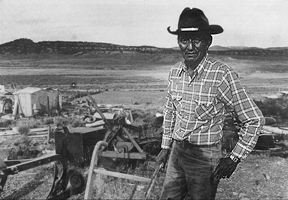 Some relocated Navajos returned illegally to their previous land. But it is more and more difficult to survive there. Due to the ban on building and repairing more and more growing families live in slowly deteriorating hogans, the traditional wooden cabins. If they try to do anything to improve their housing, they see the result of their efforts being destroyed under their very eyes by government workers. With only ten percent of the livestock they used to have they can hardly stay alive: their food consists of bread, coffee and potatoes. But they are determined not to be chased away. It has been announced in Reagan’s name that the army would be called in. The old Navajo women are prepared for it. ‘We have faced soldiers before. Until now we survived it.’ The task won’t be easy for the militaries. Some women have already been arrested for shooting over the heads of fence builders, but nobody has been charged until now. And the fence won’t keep standing.
Some relocated Navajos returned illegally to their previous land. But it is more and more difficult to survive there. Due to the ban on building and repairing more and more growing families live in slowly deteriorating hogans, the traditional wooden cabins. If they try to do anything to improve their housing, they see the result of their efforts being destroyed under their very eyes by government workers. With only ten percent of the livestock they used to have they can hardly stay alive: their food consists of bread, coffee and potatoes. But they are determined not to be chased away. It has been announced in Reagan’s name that the army would be called in. The old Navajo women are prepared for it. ‘We have faced soldiers before. Until now we survived it.’ The task won’t be easy for the militaries. Some women have already been arrested for shooting over the heads of fence builders, but nobody has been charged until now. And the fence won’t keep standing.
GENOCIDE
Resistance grows among traditional Navajos. They also more and more clearly attack the present chairman of the council, Peterson Zah. Zah presents himself as representative of the traditional people but does not work against the administration. He negotiates on how the deportations must be carried out, he does not stand against them. Together with General Electric and Bechtel, he even made plans to install a power plant of twenty thousand megawatt and a strip mine on Navajo land. The ‘old’ Navajos have nothing to expect from him. It is mainly the traditional Hopis who support them in their resistance to governmental plans. The ordinary Hopis have as little to win as the Dineh from their council’s plans, which do not leave any doubts about the fact that they will use the newly gained land for coal strip mining, of which mainly council members will get profit. Despite all the external attempts to set them against each other, most Hopis remain on the same line as the traditional Navajos. In 1981 Thomas Banyacaya published in their name a declaration of solidarity with the Dineh.
In 1982 the Big Mountain-JUA Legal Defense/Offense Committee (BMLDOC) was created in Flagstaff. Under the leadership of Big Mountain elders, the BMLDOC gives free juridical assistance to the Indian struck by the relocation program. It takes a number of legal actions against the state and campaigns to repeal PL 93-531.
Some support has come from an unexpected side. On January 1st 1982 the director of the relocation commission, Leon Berger, resigns. He calls the relocation program ‘an unprecedented disaster’ and announces that he will devote himself to the repealing of the law. In May of that year commission member Roger Lewis resigns on the same grounds.
International resistance to the consequences of PL 93-531 starts too. The jury of the Fourth Russell Tribunal, held in Rotterdam in 1980, concludes that according to the United Nations Convention it is a case of genocide. In the Netherlands NANAI, among others gets involved against the planned deportations and overall in Europe action and support groups arise.
AMENDMENTS
Even in the American Congress, expressions of concern can now be heard. Those apply mainly to the financial side of the program. The forty million dollars which PL 93-531 was going to cost have now increased to five hundred millions, en the total expenses could very well reach the two billions. In a time when drastic budget reductions are applied, the Congress cannot, towards the tax payers, allow itself to spend such an amount for an ‘intervention in a conflict between a bunch of Indian tribes’ (the image that still lives, thanks to the media). And it certainly cannot happen at all if the program, in the words of Congress member Les AuCoin, ‘can be called a major fiasco.’ A number of Congressmen begin to realize that the result of their intervention has been to turn a proud, economically independent people into a group of wretched homeless human beings depending on public help to survive. So have a few amendments been submitted aiming at postponing the forced deportations which, since July 7th of this year can happen at any time, for instance until sufficient housing has been built for the deported Navajos, which has been much delayed by the budget cuts policy. Nobody talks any more about the provisions concerning medical and educational services.
Of course, postponement does not make any difference. The deportation must not happen at all. As the Navajo resistant woman Roberta Blackgoat puts it ‘It is another way: a way of starvation and genocide’. The Dineh have as much right to their land, life and culture as the traditional Hopis. And the world needs them, because Big Mountain is everywhere .The economic, social and political forces that those people fight are also at work in the rest of the world. In a time in which the earth is getting destroyed by them, the Dineh are one of the last peoples knowing how to live without disturbing the balance of nature and having kept their spiritual unity with the earth. Let it remain like that. All support is necessary in the struggle against deportation.
Jansen

